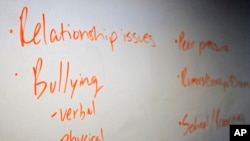Two leading U.N. agencies are warning that growing mental health disorders among children and adolescents are driving them to engage in increasingly risky, self-destructive behavior.
The World Health Organization and the U.N. children's fund, which on Thursday opened a three-day conference on the issue in Florence, Italy, reported that up to 20% of adolescents globally experience mental health disorders, with half of these conditions starting in youths before they turn 14.
Chiara Servili, a technician in WHO's Department of Mental Health and Substance Abuse, told VOA the crisis has no borders. She said children in both low- and high-income countries face depression, anxiety and emotional distress.
Youths in developing countries “may be exposed to a range of risk factors like poverty or chronic conditions, including HIV, or migration and displacement and violence,” Servili said. “These are all risk factors that have an influence on the psychosocial well-being of young people."
She said adolescents living in richer countries also have to contend with violence. They can also face stresses related to unstable families, bullying at school and through social media, and a wide range of other difficult experiences.
WHO said depression is one of the leading causes of illness and disability among adolescents worldwide. It said suicide is the third-leading cause of death in adolescents aged 15 to 19.
Servili said the stigma and shame attached to mental illness are major barriers to getting young people the help they need.
Because of the lack of awareness about mental health issues, parents, other family members, teachers and adolescents “do not recognize their experiences as related to mental health conditions,” Servili said. “The other big challenge is in relation to the availability of care providers and trained human resources."
Servili warned that untreated mental conditions have serious short- and long-term health consequences for adolescents. The inability to deal with their problems, she said, often pushes young people into alcohol and drug use, unsafe sex, violence and other risky behaviors.






